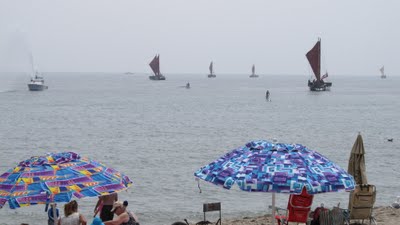Vakas of Hope
Sustainably Sailing the Pacific Seas
This is the first column on the subject of oceans that will appear online every week.
The Pacific Ocean is the largest ecosystem on the planet and covers 34 percent of the globe. It is one of the most vulnerable ecosystems on the planet. Given the importance of the ocean — and with funds from the Okeanos Foundation — a fleet of seven vakas or sailing vessels were constructed last year using old drawings of Polynesian canoes. Under a project entitled Vaka Moana, voyagers from 14 island nations, including Tahiti, Fiji, the Cook Islands, New Zealand, Tonga, New Guinea, and Samoa set sail from New Zealand five months ago using only the stars to guide them, and the wind and sun to power their journey. Each vaka includes a large solar panel on deck to garner the energy from the sun. No fossil fuels are used. Using traditional celestial navigation, a vaka’s navigator has been taught the ancient wisdom of sailing by the stars. The voyage of the vakas symbolizes the need to protect the ocean. The vakas travel the route of the green sea turtle, the flight of the albatross and sooty shearwater, and migration of whales. These beautiful sailing vessels reflect a great wisdom of the sea and our connection to one another.

The ocean’s story has gone into the wind. From Auckland, New Zealand, the seven vakas — carrying 120 sailors — stopped over in the Marquesas Islands, sailed throughout French Polynesia with a visit to Tahiti, and this past June dropped anchor in Honolulu, Hawaii. In June, I was invited to participate in the welcoming celebration in Hawaii. As I floated on my back over the coral reefs off Diamond Head awaiting the vakas, the clouds were a paintbrush-pink hue in a foreground that was the bluest salt smile. The sunset was about to burst open the night. On the blue horizon were vakas that had traveled over 48,000 miles to Honolulu.
In Hawaii, the Okeanos Foundation brought together 80 scientists, film makers, native Hawaiians, poets, writers, activists, and the sailors of the vakas to discuss the future of the ocean, and to talk ocean stories while drinking kava. The kava root is used to produce a drink with sedative and anesthetic properties, and is consumed throughout the Pacific Ocean cultures of Polynesia (including Hawaii), Vanuatu, Melanesia, and some parts of Micronesia. Kava is sedating and is primarily consumed to relax without disrupting mental clarity. It has been used for hundreds of years to mediate disputes, unite people, and foster peace. At the kava event, a single message from the diverse participants emerged — we are on one large vaka, and the ocean needs our support as we sail together in a turbulent storm that includes the threats brought on by climate change and major biodiversity loss. Without the life-giving values of a healthy ocean, we are more vulnerable and sensitive to the changes in our climate and environment.
The event concluded with a sail on the vakas in the warm waters of Oahu. Before the launch, we gathered in a circle to give thanks to the sea. Despite our diverse languages, a common message and harmony developed over time: we respect and are humbled by the great ocean.
From Hawaii, the sailors traveled up to the northeast Pacific, San Francisco, down the California coast to Monterey, and then to Santa Barbara last month. At Point Conception, the Samoan vessel broke its main mast in winds gusting to 35 knots. As they entered the Santa Barbara Channel, the vakas reached speeds of 16 knots. The next morning, the vakas’ crews found safe anchorage in the Santa Barbara Harbor.
Mike Murray, the assistant superintendent of programs for the Channel Islands National Marine Sanctuary, greeted the sailors on the Samoan vessel in the harbor. Murray recognized the importance of the visit by the vakas. “Having the vaka moana sail through the Santa Barbara Channel and Channel Islands National Marine Sanctuary was inspiring in itself, but getting the chance to welcome them was truly special,” he said. In late August, the sailors of the vakas met with the Chumash at Paradise Cove, north of Malibu. The Chumash paddled two of their tomols, or canoes, out to meet the vakas as they arrived in the cove. It was an incredibly beautiful sight. The colored sails and hand-carved wooden decks of the vakas had now traveled over 85,000 miles across the Pacific, reaching our shores to the cheers of over one hundred people on the beach. This was a union of peoples across the Pacific.

Later that evening, the crews of the vakas celebrated at the Wishtoyo Foundation’s Chumash coastal village site area at San Nicholas Canyon County Park along the Santa Monica Mountain range. The elders from the indigenous communities drank kava in a ceremonial circle. After the event, Murray noted, “Time spent with the captains and crews of the vaka moana was truly invigorating. Their optimism, strength, courage, generosity, kind spirit and focused commitment to a grand mission of Pacific ocean conservation was infused into all that formed a welcoming community around these incredible voyagers. All the better to rejuvenate our local conservation efforts and remind us of the greater ocean ecosystem to which we’re connected.” The smell of burning white sage was in the air.
You can track the path and voyage of each vaka and follow the crews’ blog at: www.pacificvoyagers.org/voyage/track-the-voyage/. The vessels will end this leg of their journey in San Diego this month. A documentary film is also being made of the journey. In January of next year, the vakas will travel from California to the Galapagos Islands off Ecuador, and then return full circle to New Zealand. It was a great honor to witness this historic journey.



